Olive trees throughout southern Italy are being killed by a plant disease called Olive Quick Decline (OQD), which begins with rapid twig and branch dieback, or "flagging" (Figure 1) and rapidly leads to the death of the tree. Although the pathogen that causes OQD is not known in Florida, producers should be on the lookout for symptoms. Symptoms often start in the upper portion of the plant and then spread toward the crown, normally within one to two months of symptom onset, producing a burned appearance. Whole groves of ancient trees, hundreds of years old in some cases, have been killed. First associated with the disease symptoms in 2013, Xylella fastidiosa (X. f.), is a bacterial plant pathogen spread primarily by several different leafhopper insect vectors (Figure 2) that feed on xylem tissue. While this disease is not currently found in Florida, there is potential for a subspecies, X. f. pauca, to be spread to the state and other areas of the United States through the movement of diseased plant tissue and insect vectors. It is important that olive growers, and homeowners with olives, monitor for potential disease symptoms and act swiftly to limit spread of the disease. The purpose of this article is to help them do so.
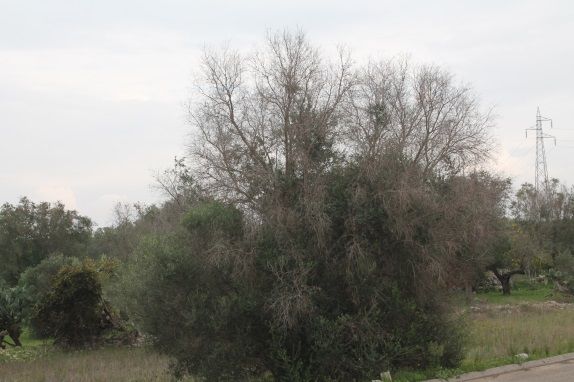
Credit: Whitney Elmore, UF/IFAS
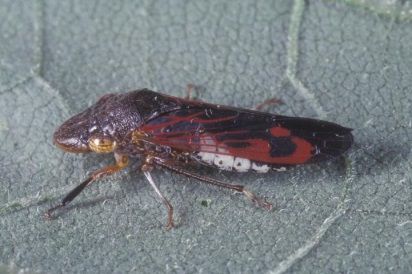
Credit: Lyle J. Buss, UF/IFAS
Xylella fastidiosa is not a newly discovered plant pathogen. It is widely known for its ability to cause Pierce's disease in grapevines as well as other scorch diseases across North America, including Florida. To date, the subspecies known to cause Pierce's disease in grapes is not believed to be associated with OQD. The subspecies of the bacterium X. f. pauca has been associated with the disease in Italy and is also endemic to parts of South America as a disease of citrus. Other X. f. subspecies currently known to the United States have not yet been reported to cause disease expression in citrus or OQD in states like California and Florida. It is, though, important for all US residents and visitors to be aware of the serious implications of moving unregulated plant and animal parts across state and country borders. For more information on this topic, please review the FDACS Summary of Plant Import Regulations.
X. f. pauca Facts
- This is a subspecies of X. fastidiosa. It is not known to cause the same disease symptoms in grape, citrus, and other broadleaf trees as it does in olives.
- The disease is vectored by xylem-feeding insects such as leafhoppers, sharpshooters, and spittlebugs.
- X. f. pauca multiplies and spreads throughout host tissue, restricting water movement in the xylem.
- Insect vectors feeding for short periods of time can acquire the bacterium and carry it to new hosts.
- X. f. pauca can also be transmitted by contaminated material during grafting.
- The full host range of X. f. pauca is not currently known.
Common X. f. pauca Infection Symptoms in Olive
- Leaf scorch moving from the tip toward the petiole (Figure 3).
- Twig and branch desiccation normally beginning in the upper branches first (Figures 4 and 5)
- Darkened xylem tissue upon inspection of limb cross-sections
- Desiccated fruit that resists drop
- Proliferation of suckers until roots are affected (Figure 6)
Not all of the symptoms must be present to diagnose an infected tree.
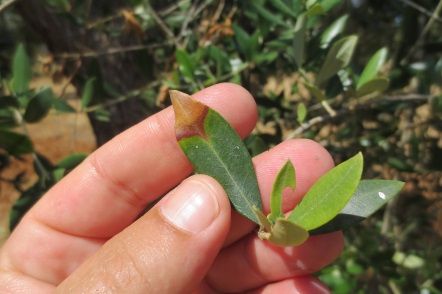
Credit: Rodrigo Kruger, USDA-ARS
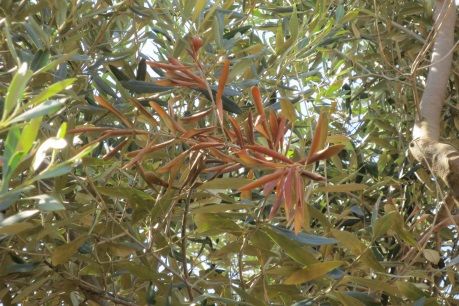
Credit: Rodrigo Kruger, USDA-ARS
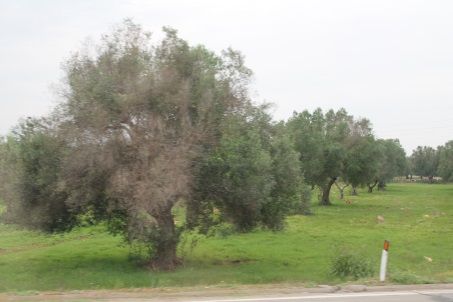
Credit: Whitney Elmore, UF/IFAS

Credit: Whitney Elmore, UF/IFAS
Recommendations
Currently there is no cure for OQD. Limited control efforts, like rapid removal of suspicious plants, are designed to prevent disease spread. Effective control of the insect vector may help slow disease spread, but spraying to control these insects has previously been attempted and found to be expensive and futile (insect vectors are known to fly long distances between hosts). Control of weeds with herbicides and close mowing of grasses in groves can also help limit insect vectors by limiting their access to other host plants. There are natural enemies to some insect vectors such as parasitic wasps in the genus Gonatocerus, as well as mantids and dragonflies. Promotion of natural enemies can help reduce insect vector populations.
For more information on sharpshooters, please see Glassy-Winged Sharpshooter, Homalodisca vitripennis (=coagulata) (Germar) (Insecta: Hemiptera: Cicadellidae: Cicadellinae) by Conklin and Mizell. To learn more about Pierce's disease and leafhoppers, please see Xylella fastidiosa Diseases and Their Leafhopper Vectors by Mizell, Andersen, Tipping, and Brodbeck.
If you suspect you have the insect vectors and/or damage from Xylella fastidiosa, please contact the authors. Visit with faculty at your local UF/IFAS Extension Office for information on how you can submit a plant sample for OQD pathogen identification at the UF/IFAS Plant Diagnostic Center.
Acknowledgments
Funding for the development of this document was provided by UF/IFAS. Special thanks to the UF/IFAS Extension administration team for their support. A 2016 Florida Cooperative Extension Service Professional Development Mini-Grant, and funds from the UF/IFAS South Central Florida Extension District and Pasco County Government provided Dr. Gillett-Kaufman and Dr. Elmore with the opportunity to visit olive groves in southern Italy to learn more about OQD and how the insect-pathogen interaction could impact Florida olive production. We would also like to thank Russ Mizell, B.J. Jarvis, and Michael Garcia for their reviews and feedback that greatly improved this document.
References
Carlucci, A., F. Lops, G. Marchi, L. Mugnai, and G. Surico. 2013. "Has Xylella fastidiosa 'chosen' olive trees to establish in the Mediterranean basin?" Phytopathologia Mediterranea. 52(3). 541–544.
Conklin, T., and R. F. Mizell. 2002. Glassy-Winged Sharpshooter, Homalodisca vitripennis (=coagulata) (Germar) (Insecta: Hemiptera: Cicadellidae: Cicadellinae). EENY-274. Gainesville: University of Florida Institute of Food and Agricultural Sciences. https://edis.ifas.ufl.edu/publication/in552
Elliott, M., K. Pernezny, A. Palmateer, and N. Havranek. 2008. Guidelines to Identification and Management of Plant Disease Problems: Part I. Eliminating Insect Damage and Abiotic Disorders. PP-248. Gainesville: University of Florida Institute of Food and Agricultural Sciences. https://edis.ifas.ufl.edu/publication/mg441 (no longer available)
Gillett-Kaufman, J. L., S. A. Allan, J. H. Bosques-Mendez, and L. J. Buss. 2014. Pests and fungal organisms identified on olives (Olea europaea) in Florida. ENY-871. Gainesville: University of Florida Institute of Food and Agricultural Sciences. https://edis.ifas.ufl.edu/publication/in1046
Manceau, C. 2016. "Disease outbreaks caused by Xylella fastidiosa in Europe are due to multiple introductions." Journal of Plant Pathology. 98 (Supplement). S13.
Tipping, C., and R. Mizzell. 2009. Sharpshooters, leafhoppers, Cicadellidae (Insecta: Hemiptera: Auchenorrhyncha: Cicadellidae). EENY-334. Gainesville: University of Florida Institute of Food and Agricultural Sciences. https://edis.ifas.ufl.edu/publication/in611